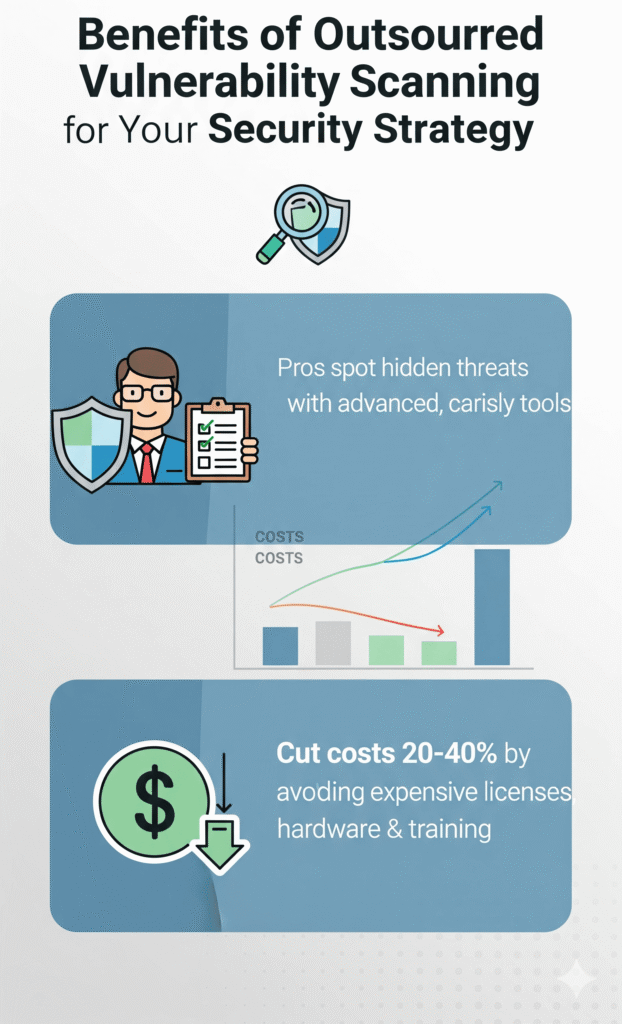Address
304 North Cardinal St.
Dorchester Center, MA 02124
Work Hours
Monday to Friday: 7AM - 7PM
Weekend: 10AM - 5PM
Address
304 North Cardinal St.
Dorchester Center, MA 02124
Work Hours
Monday to Friday: 7AM - 7PM
Weekend: 10AM - 5PM

Most businesses don’t really get what outside security scanning brings to the table. It’s not just running some automated scans , it’s having sharp, eyed pros who spot the problems others miss. When companies try to handle everything in-house, they stretch their teams thin and end up cutting corners.
That’s where bringing in specialists makes sense: they’re running scans 24/7, using updated tools, and focusing on real threats (not just false alarms). Getting started doesn’t cost an arm and a leg either. Want to know the nuts and bolts? Keep reading.

Anyone who’s spent time in cybersecurity knows it’s not just about having fancy tools , it’s about really getting what makes systems tick.
There’s something different about watching external experts work. They’ve seen thousands of systems across dozens of industries, and they pick up on things that’d probably slip right past most in-house teams.
These folks come equipped with some serious firepower too. Their scanning tools (the kind that’d cost us an arm and a leg to buy) catch problems with scary accuracy. No more wasting afternoons chasing down false alarms. Been there, done that.
Microsoft’s threat intelligence highlights that healthcare organizations can lose roughly $900,000 per day in downtime after a ransomware event, and disclosed average ransom payments reported in one set of healthcare incidents were in the multi-million dollar range (~$4.4M average in disclosed cases) (1).
What you’re actually getting:
Let’s be honest , running this stuff in,house gets expensive fast. Between software licenses that cost more than a new car and keeping staff trained on the latest threats, the bills pile up quickly. Some estimates show effective outsourcing can reduce overall production costs by 20-40% per year (2).
And that’s not even counting the hardware costs or the time your IT team spends managing it all instead of handling actual business needs.
Outsourcing cuts those capital expenses down to size. You’re looking at a predictable monthly fee instead of massive upfront costs. Plus, your IT team can focus on what they’re actually meant to be doing.
The math works out like this:

Credit: pexels.com (Photo by ThisIsEngineering)
There’s something kind of backwards about only checking for vulnerabilities once in a while. It’s like leaving your front door unlocked most of the time and just checking it occasionally. Outsourced services let you scan as often as you need daily, weekly, whatever works for your setup.
The flexibility means you can ramp up scanning when things get dicey or scale back during slower periods. And since they’re always watching, new threats get caught pretty quick.
Think about it:
Nobody wants to drown in an ocean of security alerts. That’s probably why more companies turn to outside help, they’re tired of staring at endless spreadsheets wondering what actually matters.
When you’ve got thousands of scan results, you need someone to tell you what to fix first. Outside security teams don’t just dump data in your lap , they’ll flag what could actually hurt your systems right now. Your IT folks get a clear picture: fix these critical issues today, handle those medium ones next week.
The reports aren’t filled with techno,babble either. You get real explanations about why something’s dangerous and exactly how to fix it. Makes a big difference when you’re trying to explain things to management or auditors.
Key stuff you’ll see:
Here’s the thing about scanning for problems yourself , it’s a lot harder than it looks. You need people who really know their stuff, and they can’t just learn it once.
The security world changes every day, which is why many businesses weigh the differences between a vulnerability assessment vs penetration test before deciding how to cover all angles.
Running your own scanning takes:
Your internal team knows your network like the back of their hand, which is great. But sometimes they’re too close to see everything. They might miss stuff that’s hiding in plain sight.
Getting outside help means you don’t have to worry about any of that. They bring their own tools, their own experts, and they can scale up when you need more coverage. Plus, they’re looking at your network with fresh eyes, and might spot things your team missed while they were putting out other fires.

Credit: pexels.com (Photo by Pixabay)
Nobody really thinks about scans until something breaks. That’s where managed vulnerability management comes in , it’s not just about running basic checks on your system.
There’s actual teeth behind them, with written agreements that spell out exactly when scans happen, how good they need to be, and how fast someone’s gonna jump when big problems pop up. No more hoping things get done right.
These services don’t just watch for problems, they’re also lifesavers when the auditors come knocking. They pump out reports that match up with whatever rules you need to follow, whether it’s PCI DSS, ISO 27001, or that headache called GDPR.
Makes life way easier when you’ve got to prove you’re doing things by the book.
Let’s face it , keeping up with industry rules isn’t optional anymore, and vulnerability management services make sure checks aren’t something you skip. Outsourcing the scanning part takes some weight off your shoulders.
The system runs like clockwork (when it’s set up right), and keeps an eye on things 24/7 so you don’t have to.
We’ve watched plenty of companies drag themselves through audits. But with these services? The whole process gets smoother. The reports actually make sense, and you’re not scrambling at the last minute to piece everything together.
These services typically handle compliance stuff like:
When you line up your scanning with these frameworks, you’re basically showing everyone you mean business about security. No cutting corners here.
Let’s face it , scaling security isn’t easy. But outsourced scanning grows right alongside your network, without the usual headaches of hiring sprees or buying more servers. It’s pretty straightforward stuff.
The pricing setup’s flexible too. Need to scan more systems? Less? No problem. Monthly costs stay predictable (none of those nasty surprise bills that make accounting lose their minds), and the whole thing just works.
Most companies running these services keep their eyes on your systems around the clock. When something sketchy pops up at 3 AM, they’re on it. That’s definitely better than finding out about problems after hackers do.
These teams don’t just throw alerts at you and run , they’ll actually help fix things, point out weak spots, and make sure everything fits with whatever security stuff you’ve already got going on. Makes sense, right?
Adding outsourced scanning’s kind of like putting another lock on your door, it works with everything else you’re doing to keep things safe. You get to see what’s wrong 24/7, which beats finding out the hard way.
From what we’ve seen, this whole setup tends to:
No fancy magic here, just solid security that actually does what it’s supposed to do. And isn’t that the point?
Outsourced vulnerability scanning makes sense , it’s not just about saving money, it’s about getting real experts to watch your back. Think of it as having a whole team of security pros (with their fancy tools and 24/7 monitoring) filling in where most companies fall short.
They spot the weak points, rank what needs fixing first, and tell you exactly what to do about it. For any business that’s serious about keeping hackers out and staying within the rules, bringing in outside scanning help just works.
It grows with you, adapts when things change, and catches problems before they blow up. And let’s be honest , most companies don’t have the time or people to do this right on their own.
Maybe it’s time to take a hard look at your security setup. If you’re worried about cyber threats (and who isn’t these days), outsourced scanning might be exactly what you need. Every company’s different , but there’s probably a service out there that fits yours just right.
And if you’re a Managed Security Service Provider (MSSP), the right consulting can take your services even further. We offer expert guidance to streamline operations, reduce tool sprawl, and boost service quality.
From vendor-neutral product selection and auditing to stack optimization and decision support, we help you choose the right tools, improve integration, and enhance visibility.
With 15+ years of experience and 48,000+ projects delivered, our services include needs analysis, vendor shortlisting, PoC support, and actionable recommendations, so you can build a tech stack that truly aligns with your goals and maturity level.
See how outsourced scanning and MSSP consulting can strengthen your security setup
Outsourced vulnerability scanning benefits include specialized vulnerability scanning expertise, continuous vulnerability scanning, and stronger vulnerability risk reduction. With managed vulnerability services or vulnerability management outsourcing.
Vulnerability scanning as a service provides compliance vulnerability scanning, regulatory compliance vulnerability scanning, and proactive vulnerability scanning. Organizations gain clearer vulnerability scanning reporting, external vulnerability scanning, and vulnerability scanning audit preparation.
Vulnerability remediation outsourcing helps teams focus on high-priority issues, while vulnerability scan prioritization and vulnerability remediation prioritization ensure the most serious threats are fixed first. This approach supports vulnerability risk prioritization, enabling vulnerability remediation time reduction.
Vulnerability scanning automation and vulnerability scan reporting automation make it easier to achieve vulnerability scan false positives reduction. Automated vulnerability scanning benefits include faster detection, stronger vulnerability scan operational efficiency.